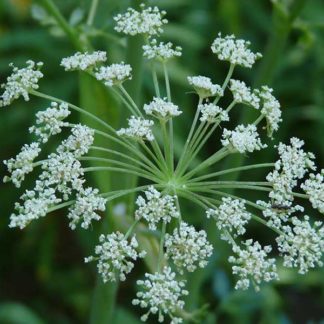toxic
Showing 1–12 of 31 results
-

Actaea rubra / red baneberry
- large, coarsely toothed, deeply lobed compound leaves
- clusters of teeny white flowers that look feathery or fluffy (due to stamens)
- green berries in late summer, maturing to red or white
- black dot at tip of each berry
- moist understory or shade
-

Anemone multifida / cutleaf windflower
- usually 5 bi-colored "petals" - esp. pink or white; many stamens
- leaves deeply cut and re-cut in 3s with rounded or pointed tips
- stems and lower leaf surfaces usually hairy
- gone to seed, fruits have a troll-doll look
- on calcareous ledges, in shallow crevices or rocky outcrops; dry mountain tops or near water
-

Anticlea elegans / mountain death camas
- cream to greenish-white flowers; overall hexagonal appearance
- branched flowering stem with multiple flowers not tightly packed
- 6 tepals (petals + sepals), greenish-yellow nectar glands
- grass/lily-like leaves
- blooms in summer (July/August)
-

Apocynum androsaemifolium / spreading dogbane
-
short and spreading perennial
-
oval leaves with pointed tips, prominent veins
-
clusters of teeny, pink, bell-shaped flowers with recurved petals
-
conspicuous darker pink stripes on inner surface of corolla
- exudes milky sap when stems or leaves are broken
-
-

Apocynum cannabinum / common dogbane
- herbaceous perennial with red stems and long/narrow leaves
- leaves have prominent veins
- leaves and stems exude white latex if broken
- white, bell-shaped flowers held erect in stalked clusters
- seedpods long, thin and brownish; in pairs
- often near streams or in moist places
-

Artemisia ludoviciana / white sage
- low, spreading perennial - up to 3 feet tall
- silvery leaves and stems (hairy)
- leaves lance shaped, but sometimes lobed
- shoots die back in winter
- aromatic
-

Astragalus miser / timber milkvetch
- compound leaves with small, egg-shaped leaflets
- teeny, pea-like flowers - bicolored but overall blue/purple
- keel tip is purple and pointed
- small, hairy seed pods
- grassland, meadows, and other open communities
-

Astragalus purshii / woollypod milkvetch
- low growing, silvery, compound leaves; no tendrils
- magenta (or white) "pea-like" flowers with darker keel petal
- "congested" inflorescence
- found in very dry areas, not in shade
-

Beteroa incana / hoary alyssum
- dense clusters of teeny white flowers
- 4 petals, each with a notch
- fruit is a short, fat-ish seed pod (silicle)
- found in pastures and all manner of disturbed habitats
- toxic to horses
-

Cicuta douglasii / water hemlock
- HIGHLY TOXIC
- primarily on continuously wet soils, e.g. ditches, stream banks, pond margins, marshes.
- white compound umbel inflorescence typical of the Apiaceae/Umbelliferae
- multiply compound leaves with prominent veins ending in notches between lobes
-

Corydalis aurea / scrambled eggs
- prostrate herb, up to 15" tall
- moist but well-drained soils, including on roadsides
- yellow tubular flowers, with spurs
- highly dissected leaves, blue-grey except when young
- fruits are pod-like, resembling peas or beans
-

Cynoglossum officinale / houndstongue
- reddish-purple flowers in upper leaf axils
- forms basal rosette with hairy leaves in first year
- stem leaves lance shaped, hairy, rough
- fruit - small nutlets with barbs or hooks
Showing 1–12 of 31 results